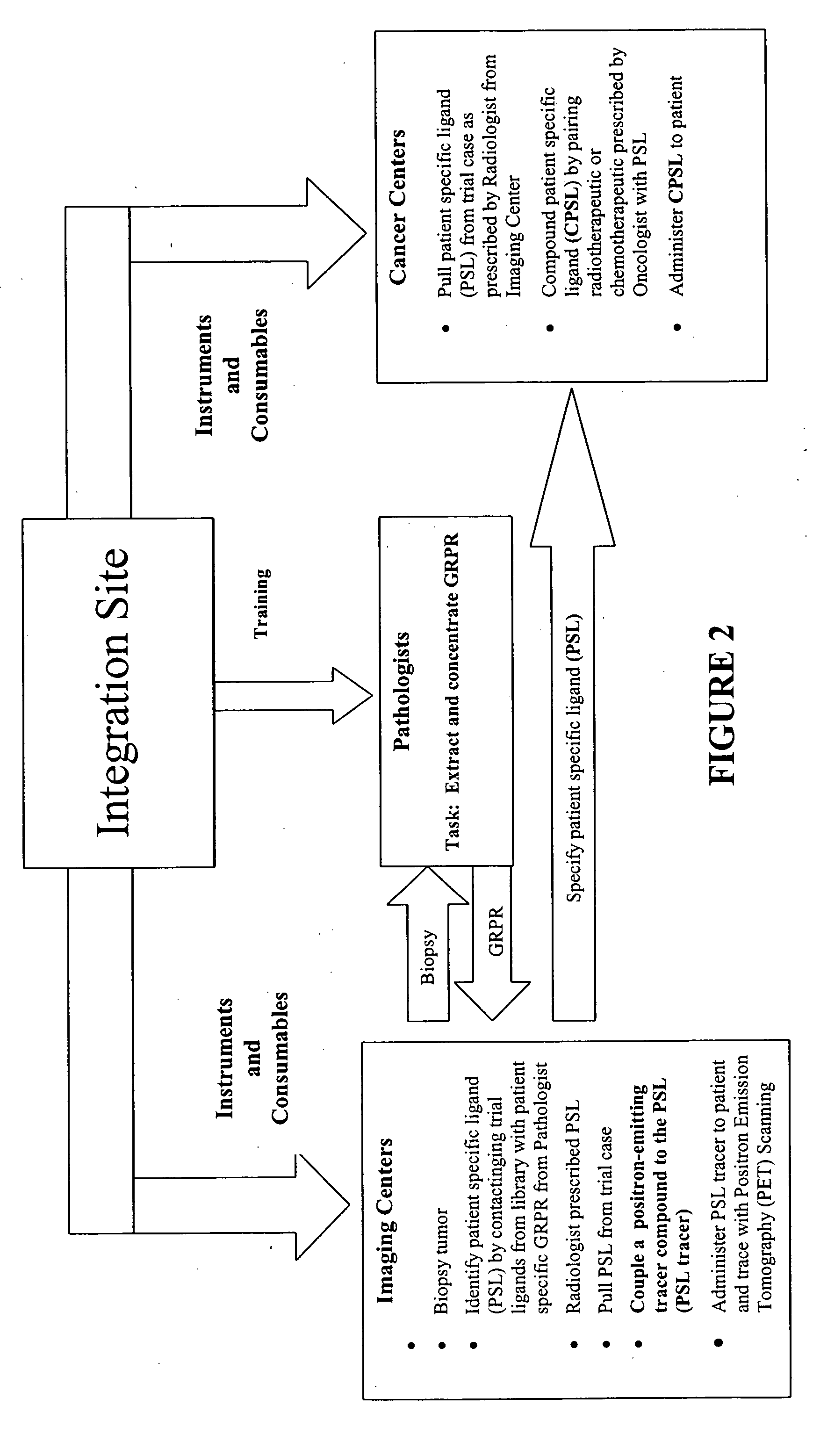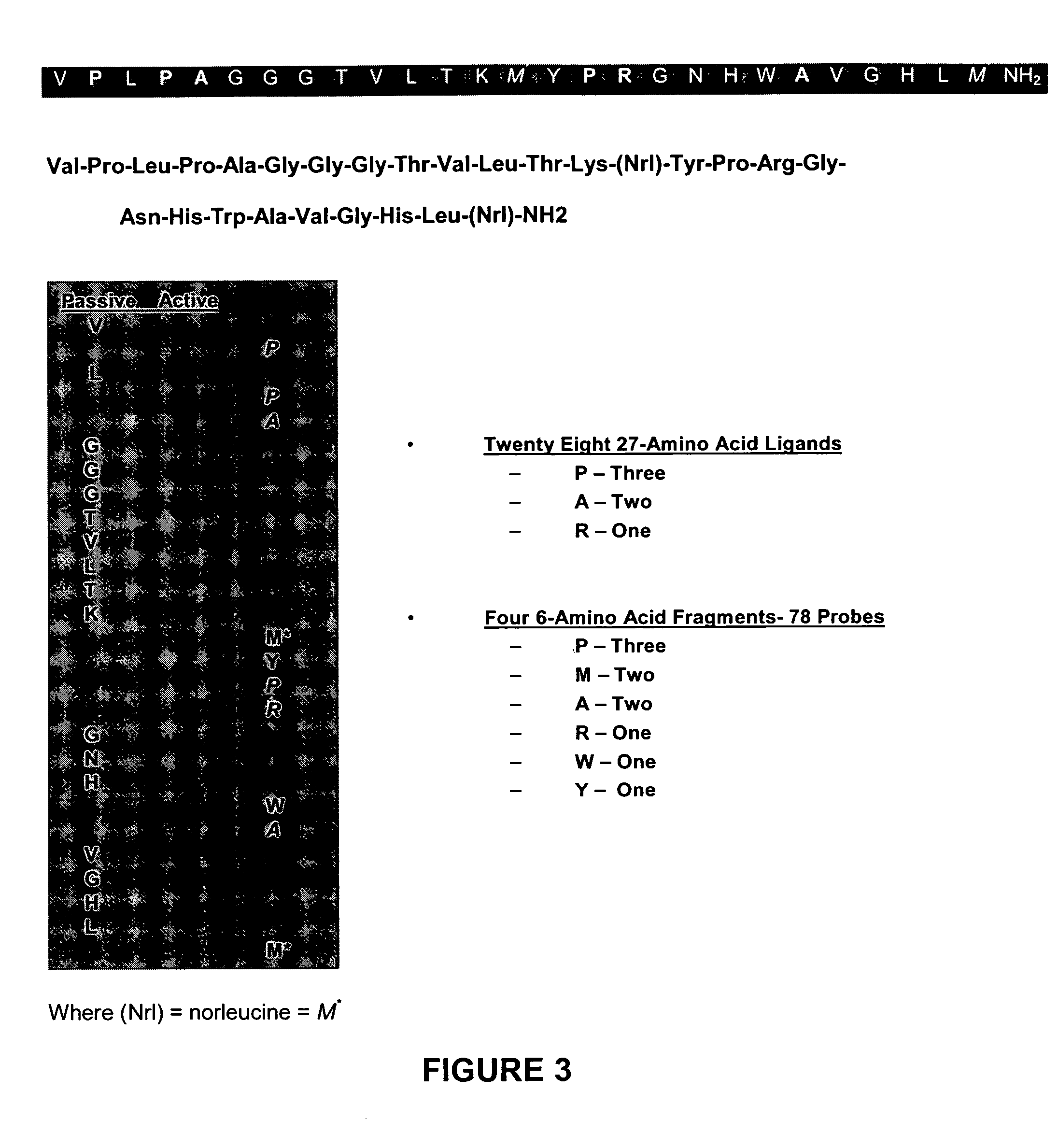Method, compositions and classification for tumor diagnostics and treatment
a tumor and composition technology, applied in the field of tumor diagnostics and treatment, can solve the problems of not necessarily identifying benign or irregular tissues, increasing the incidence of either false positives or operator errors, and achieving the effects of enhancing nuclear medical imaging, reducing overall healthcare costs, and enhancing survival
- Summary
- Abstract
- Description
- Claims
- Application Information
AI Technical Summary
Benefits of technology
Problems solved by technology
Method used
Image
Examples
example 1
[0147] In the present invention a population 27 ligands plus the ligand in claim 1 is defined using combinations of the three active amino acids with first-order Chiral activity (Proline, Alanine and Arginine) that occur in six of the 27 positions. This population is reduced to a total population of nine by use of affinity HPLC analysis as taught herein. In the analysis extraction of the patient's GRP-r from prostate cancer tissue is performed by the steps of composite sampling, separation, enrichments, re-suspension and mining the active fragment. Tests are performed on 50 prostate cancer tumors from archival or biopsy specimens of 50 patients. Each sample is one milliliter of clear solid free liquid at a concentration of an estimated 300 micrograms per milliliter of GRP-r and is obtained from tissue samples of 1 grams wet weight of prostrate tissue. The steps in the preparation of the GRP-r are described in the following paragraphs.
Composite Tissue Sample:
[0148] Aliquots of sur...
example 2
[0161] In the present invention an extract of the patient's GRP-r is captured in a trap containing suitable affinity chromatography media (the Trap) and the Level One ligand is: chemically tagged with fluorescence dye, contacted with the Trap and the presence of same measure in the discharge from the Trap. A reduction in the fluorescence in the discharge from the Trap greater than the expected dilution shows that GRP-r is present in the Trap and bound to some quantity of the ligand and presumes that the patient has cancerous cells. This presumption of cancer is to be confirmed by other tests not within the scope of this invention. The equipment used and the methods of analysis are described in the following paragraphs.
[0162] The equipment and major chemicals used are:
[0163] Fluorometer—Turner PicoFluor model number 80003 with mini cell adapter and cells model 8000-931; Fluorescent Dye—Molecular Probes AlexaFluor 488 a TFP ester model number A30005; Affinity Trap—Amershampharmaciab...
example 3
[0165] In the present invention radioactive tagging to form radiopharmaceuticals is added at the PET scan location or point of use by organometallic chemistry without the need for a cyclotron. The method used is described in the following paragraph.
[0166] The organometallic aquaion [99mTc(H2O)3(CO)3]+ is used as a radiosynthon for the labeling of the bioactive ligand molecule for use in PET scans. The NH2 terminus of the 27 mer ligand is functionalized to achieve radiolabeling by forming a high specific activity radiocomplex while maintaining the biological activity of the ligand. The aquaion is stable over a wide range of pH values and is characterized by excellent labeling efficiency. The labeling efficiency is associated with the presence on the three water molecules coordinated to thefac-M(CO)3 which is characteristic of the aquaion not only the amine donor group in the present invention but also with thiols, phosphines and thioesters as donor groups.
PUM
| Property | Measurement | Unit |
|---|---|---|
| diameter | aaaaa | aaaaa |
| area | aaaaa | aaaaa |
| interaction energy Ee | aaaaa | aaaaa |
Abstract
Description
Claims
Application Information
 Login to View More
Login to View More - R&D
- Intellectual Property
- Life Sciences
- Materials
- Tech Scout
- Unparalleled Data Quality
- Higher Quality Content
- 60% Fewer Hallucinations
Browse by: Latest US Patents, China's latest patents, Technical Efficacy Thesaurus, Application Domain, Technology Topic, Popular Technical Reports.
© 2025 PatSnap. All rights reserved.Legal|Privacy policy|Modern Slavery Act Transparency Statement|Sitemap|About US| Contact US: help@patsnap.com



